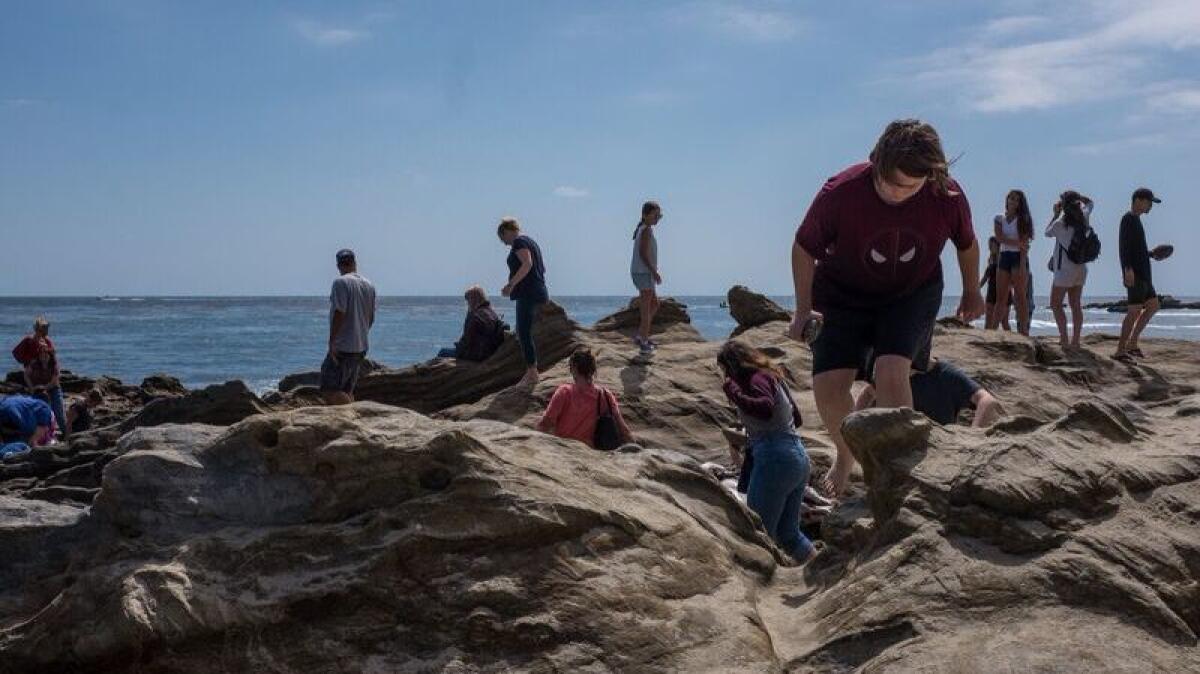Column: Despite warning signs, visitors caused undue harm to tide pools

- Share via
I was looking for the 17 million-year-old fossils below Heisler Park in Laguna Beach recently when I noticed the family from out of town with three small children scampering like sand crabs, carrying cheap plastic buckets and fish aquarium nets.
What exactly are they doing with fish aquarium nets? I wondered.
And then I saw.
Splashing around in a tide pool, mucked up with sand and chaos, they were trying to catch little fish.
The dad was helping, pointing out the darting shadows, as if that would really help.
The nets slapped the water like a baseball bat, followed by the sad groan of a missed pitch.
I admit I temporarily lost it.
“What in the hell are you doing?” I yelled from maybe 30 yards away.
The dad either didn’t hear me or chose to ignore me.
“Excuse me,” I said, walking closer as the kids kept swinging away. “Hey, hey, hey ...”
The dad looked up. I was shaking my head.
“No, no, you can’t do this.”
He looked at me with bewilderment and said, “Do what?”
“This,” I said, waving my arms in a circle toward the children. “All of this.”
“You know it’s a $1,000 fine to take anything from here,” I said, pointing to the State Marine Reserve protection sign.
He then sort of grunted and barked at his kids as he pulled them out of the batter’s box.
I walked away in search of my fossils, shaking my head.
Unbelievable.
Here’s the thing. A version of that scene happens almost every single summer day in Laguna Beach.
Every day, every cove, every reef.
It is worse at Heisler and Treasure Island because they get most of the tourists, but it happens everywhere.
In my 11 years in Laguna, I’ve thought about this problem a lot, and I have a theory: It’s the fault of puka shells.
Those ubiquitous Hawaiian shells – now ridiculed as a surfer trope – were nearly stolen out of existence. Like any natural resource, they were loved to death. Any puka necklace you see now is probably fake.
But back in the day – for decades – puka shells were taken from beaches. Post World War II, and especially after the ’60s and the rise of surf culture, all items at the beach were fair game because they were “public.”
Generations of kids took shells, interesting rocks and basically anything that looked cool. It was a given, it was free, it was our right.
That attitude has not really changed. I know for a fact because I see it almost every day.
The official Laguna Ocean Foundation docents see it too. More than 80 overworked volunteers try to educate people about why it’s not OK to poke a stick into an urchin.
“Heisler is a real tough one to cover,” said Robin Zur Schmiede, chair of the board of directors. “We sometimes try and schedule two or three – sometimes four – educators down there on the holidays that we know are going to be busy, or the weekends, but as our educator coordinator said to me once, how are you going to get enough people out there for 800 people?”
You have to wonder if education is enough. With little kids, sure, they probably don’t know any better. But when you reach a certain age, you know better.
Everywhere you look on Laguna’s beaches there are warning signs in big red letters, but maybe warning signs are not enough. Maybe we just block off access to distressed areas until they get healthier.
It’s clear if you compare Heisler to the rocky intertidal zone of say, Woods Cove, that there is no comparison. It’s like the Mojave versus Bali.
Somehow, thankfully, the stampede is not preventing the sea stars from returning after being on death’s door. I think that’s only because the stars remain largely hidden in the mid-to-low tidal zone, away from the riff-raff.
So when I finally reached those 17 million-year-old fossils, a lot of them were damaged from people trying to dig them out of the rocky cliff.
Why should I be surprised? It’s hard to have hope that anything is going to survive humans.
When I left the fossils and walked back past the family, the buckets and nets were safely on a beach towel, but the kids were still in the shallow tide pool, this time treating it like a private bath. One youngster was immersed in the water and sand doing a snow angel.
The dad was videotaping it with his cellphone.
David Hansen is a writer and Laguna Beach resident. He can be reached at [email protected].
DAVID HANSEN is a writer and Laguna Beach resident. He can be reached at [email protected].
All the latest on Orange County from Orange County.
Get our free TimesOC newsletter.
You may occasionally receive promotional content from the Daily Pilot.



